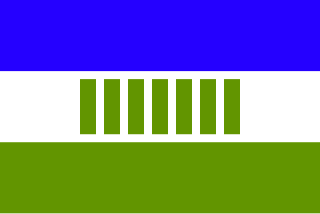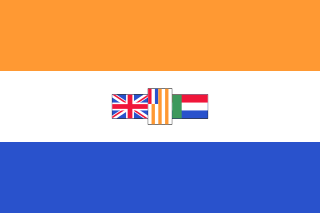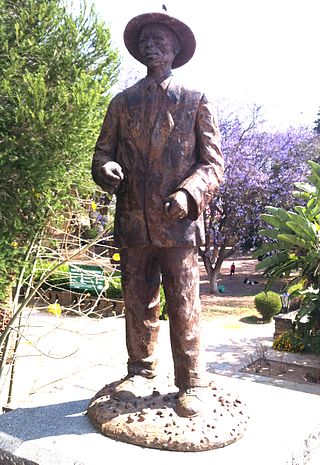
South West Africa was a territory under South African administration from 1915 to 1990, after which it became modern-day Namibia. It bordered Angola, Botswana, South Africa, and Zambia.
The history of Namibia has passed through several distinct stages from being colonised in the late nineteenth century to Namibia's independence on 21 March 1990.

A Bantustan was a territory that the National Party administration of South Africa set aside for black inhabitants of South Africa and South West Africa, as part of its policy of apartheid. By extension, outside South Africa the term refers to regions that lack any real legitimacy, consisting often of several unconnected enclaves, or which have emerged from national or international gerrymandering.

Khoekhoen are the traditionally nomadic pastoralist indigenous population of southwestern Africa. They are often grouped with the hunter-gatherer San peoples. The designation "Khoekhoe" is actually a kare or praise address, not an ethnic endonym, but it has been used in the literature as an ethnic term for Khoe-speaking peoples of Southern Africa, particularly pastoralist groups, such as the !Ora, !Gona, Nama, Xiri and ǂNūkhoe nations.

Nama are an African ethnic group of South Africa, Namibia and Botswana. They traditionally speak the Nama language of the Khoe-Kwadi language family, although many Nama also speak Afrikaans. The Nama People are the largest group of the Khoikhoi people, most of whom have disappeared as a group, except for the Namas. Many of the Nama clans live in Central Namibia and the other smaller groups live in Namaqualand, which today straddles the Namibian border with South Africa.

Hereroland was a bantustan and later a non-geographic ethnic-based second-tier authority, the Representative Authority of the Hereros, in South West Africa, intended by the apartheid-era government to be a self-governing homeland for the Herero people.

Ovamboland, also referred to as Owamboland, was a Bantustan and later a non-geographic ethnic-based second-tier authority, the Representative Authority of the Ovambos, in South West Africa.

Damaraland was a name given to the north-central part of South West Africa, which later became Namibia, inhabited by the Damaras. It was bordered roughly by Ovamboland in the north, the Namib Desert in the west, the Kalahari Desert in the east, and the Windhoek region in the south.

Tswanaland was a bantustan and then later a non-geographic ethnic-based second-tier authority, the Representative Authority of the Tswanas, in South West Africa, in the far central eastern area of the territory around the village of Aminuis. It was intended by the apartheid government to be a self-governing homeland for the Tswana people.

Kavangoland was a bantustan and then later a non-geographic ethnic-based second-tier authority, the Representative Authority of the Kavangos, in South West Africa, intended by the apartheid government to be a self-governing homeland for the Kavango people.

East Caprivi or Itenge was a bantustan and later a non-geographic ethnic-based second-tier authority, the Representative Authority of the Caprivis in South West Africa, intended by the apartheid government to be a self-governing homeland for the Masubiya people.

Frans Hendrik Odendaal (1898–1966) was a South African politician, governor of the Transvaal province, best remembered for heading the commission that became known by his last name.

Land reform is an important political and economic topic in Namibia. It consists of two different strategies: resettlement, and transfer of commercially viable agricultural land. Resettlement is aimed at improving the lives of displaced or dispossessed previously disadvantaged Namibians. Farms obtained by government for resettlement purposes are usually split into several sections, and dozens of families are being resettled on what had previously been one farm. Transfer of commercial agricultural land is not directly conducted by government. Would-be farmers with a previously disadvantaged background obtain farms privately or through affirmative action loans. In both cases, the "Willing buyer, willing seller" principle applies.

Captain Hendrik Samuel Witbooi, Nama name: ǃGae-nûb ǃnagamâb ǃNansemab, was the sixth Kaptein of the ǀKhowesin, a subtribe of the Orlam, in the area of South-West Africa (SWA), today's Namibia. He was born in Gibeon; Hendrik Witbooi was his grandfather. He was selected to be the successor of his uncle David Witbooi who died in 1955.
Hoachanas is a settlement of 3,000 inhabitants in the Hardap Region of southern central Namibia, located 55 kilometres (34 mi) northeast of Kalkrand. It is situated at the junction of the main road C21 from Kalkrand, and C15 from Dordabis to Stampriet and belongs to the Mariental Rural electoral constituency.
Amraal Lambert, Nama name: ǂGaiǀnub, was the first Captain of the Kaiǀkhauan, a subtribe of the Orlam, in the eastern area of Namaland, today's Namibia.
Uibis, sometimes: Uibes, is an informal settlement in the Hardap Region in southern central Namibia. It is situated on Hutup River 100 kilometres (62 mi) from Mariental on the gravel road between Gibeon and Maltahöhe.

Aminuis is a cluster of small settlements in the remote eastern part of the Omaheke Region of Namibia, located about 500 km east of Windhoek. It is the district capital of the Aminuis electoral constituency.
Isaak Witbooi, Nama name: ǃNanseb ǂKharib ǃNansemab, was the fourth Kaptein of the ǀKhowesin, a subtribe of the Orlam, in Gibeon, South-West Africa. When during the Herero Wars his father, Hendrik Witbooi, fell on 29 October 1905, he inherited the chieftaincy and continued fighting the German troops, but surrendered on 3 February 1906. The German colonial government formally abolished the traditional leadership structures and kept the ǀKhowesin including Isaak Witbooi detained in the North of Namibia, unable to return to Gibeon until the World War I surrender of local German troops to invading British-South African forces in 1915. At Gibeon, Isaak Witbooi succeeded in rebuilding the social organisation of the ǀKhowesin, despite being only recognised as "local headman" by the South African administration. He reigned until his death in 1928, when his brother David Witbooi succeeded him.
Cupido Witbooi, variations: Kido and Kiwitti Witbooi, Nama name: ǂA-ǁêib ǃGâmemab, was the first Kaptein of the ǀKhowesin, a subtribe of the Orlam of South-West Africa, present-day Namibia.















